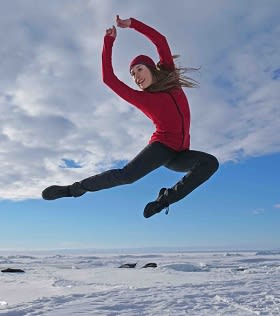Corey Baker films Antarctica dance for Channel 4
Choreographer Corey Baker filmed on Antarctica for a dance film featuring Madeleine Graham of the Royal New Zealand Ballet.
By Nick Goundry 30 Apr 2018

Choreographer Corey Baker filmed on Antarctica for a dance film featuring Madeleine Graham of the Royal New Zealand Ballet.
Channel 4 brand Random Acts commissioned Baker’s film - entitled Antarctica: The First Dance - that was launched on Earth Day (22 April) to highlight the impact of climate change on Antarctica and its surrounds.
“This project was born because of my fascination with Antarctica and wanting to put dance in it and film it,” says Baker, in comments to KFTV.
“The knowledge of the continent being under threat by severe climate change impact made it all the more urgent to go out there and capture some of its lesser-known sites on film, before it is too late.”
Baker and his team worked closely with Antarctica NZ to arrange all the necessary permits, to figure out the logistics of operating with a small crew and to plan the most suitable equipment choices, including the use of a drone.
They travelled to Antarctica from New Zealand with the US Air Force and stayed at Scott Base during filming. The facility is New Zealand’s Antarctic home on Ross Island, a short hop from the frozen continent’s mainland.
Some of the challenges of the shoot were predictable. The team knew that the cold conditions would impact their equipment and that they would be susceptible to rapid weather changes. Other elements were trickier to foresee.
“One is how different it was dancing on the snow on location from how we expected it to be, after rehearsing on an ice rink and the Snow Room at the International Antarctic Center in Christchurch, New Zealand,” Baker tells KFTV.
“It proved very hard and unpredictable – with just a step away we’d sometimes find ourselves a metre deep in snow. Half the locations we wanted to dance and film in we couldn't go to because it was just too unsafe and we couldn't predict if the ice below was solid.
“When we did get a location, there would only ever be a small part of it that was solid, stable and reliable.”
Baker and his team also found a challenge in adapting to the 24-hour sunlight of the Antarctic summer. Goggles were worn all the time as protection but these were constantly coming off in order to be able to see into a camera viewfinder or look at a monitor, which only increased the team’s exposure to the sun.
The film was made over the course of a week that included travel time to and from Antarctica.
Images: Jacob Bryant
“This project was born because of my fascination with Antarctica and wanting to put dance in it and film it,” says Baker, in comments to KFTV.
“The knowledge of the continent being under threat by severe climate change impact made it all the more urgent to go out there and capture some of its lesser-known sites on film, before it is too late.”
Baker and his team worked closely with Antarctica NZ to arrange all the necessary permits, to figure out the logistics of operating with a small crew and to plan the most suitable equipment choices, including the use of a drone.
They travelled to Antarctica from New Zealand with the US Air Force and stayed at Scott Base during filming. The facility is New Zealand’s Antarctic home on Ross Island, a short hop from the frozen continent’s mainland.
Some of the challenges of the shoot were predictable. The team knew that the cold conditions would impact their equipment and that they would be susceptible to rapid weather changes. Other elements were trickier to foresee.
“One is how different it was dancing on the snow on location from how we expected it to be, after rehearsing on an ice rink and the Snow Room at the International Antarctic Center in Christchurch, New Zealand,” Baker tells KFTV.
“It proved very hard and unpredictable – with just a step away we’d sometimes find ourselves a metre deep in snow. Half the locations we wanted to dance and film in we couldn't go to because it was just too unsafe and we couldn't predict if the ice below was solid.
“When we did get a location, there would only ever be a small part of it that was solid, stable and reliable.”
Baker and his team also found a challenge in adapting to the 24-hour sunlight of the Antarctic summer. Goggles were worn all the time as protection but these were constantly coming off in order to be able to see into a camera viewfinder or look at a monitor, which only increased the team’s exposure to the sun.
The film was made over the course of a week that included travel time to and from Antarctica.
Images: Jacob Bryant
Latest news & features
Promote your services with KFTV
Choose from three profile types - Basic, Silver and Gold
Create ProfileWe offer a range of display advertising opportunities.
Learn More